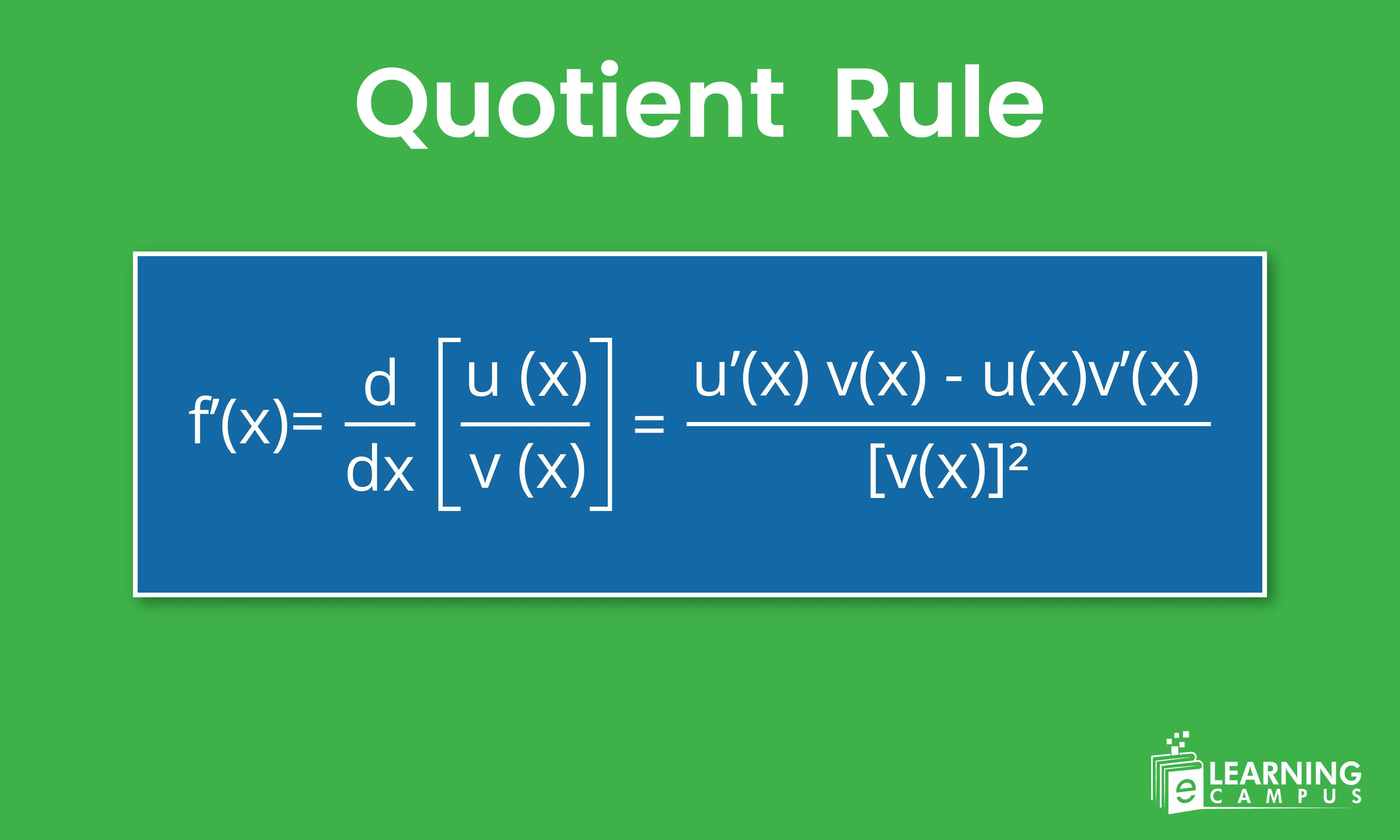Quotient Rule

Have you ever wondered how to find the derivatives of one function divided by another? When it comes to differentiating functions, there is are variety of rules to make the process easier. One of the most important tools is the quotient rule, which helps differentiate functions that are divided by one another.
In this blog, we provide easy explanations, step-by-step examples that help you to learn faster and more confidently. Whether you are exploring calculus rules, algebra concepts, or math topics, our guide provides a simple, engaging, and effective concept to understand.
What is the Quotient Rule
The quotient rule (sometimes called the quotient theorem ) is a differentiation rule that helps find the derivative of a quotient between two functions. Mathematically, it is represented as;
Here;
u=numerator function
v=denominator function
Quotient Rule Derivative
The quotient rule derivative gives the slope of a divided function at any point.
It is a key part of learning differentiation and helps avoid mistakes when dealing with fractions in calculations.
Formula;
How to use the Quotient Rule in Differentiation
The quotient rule is used when you need to differentiate a fraction, that is, when one function is divided by another.
A function is written as:
The quotient rule formula is:
Where;
u(x)=Numerator function
v(x)=denominator function
𝑢′(x)and v′(x)=their respective derivatives
Example 01
Find the derivative of
Step 01;
Step 02;
Step 03;
Step 04;
Calculus Quotient Rule
The quotient rule is one of the key tools for solving real-world problems involving rates of change. It is used in physics, economics, and engineering, where quantities depend on each other through ratios.
It combines derivatives, algebra, and simplification to produce exact results.
If you have a function
Where;
u(x)=Numerator function
v(x)=denominator function
𝑢′(x)and v′(x)=their respective derivatives
Example 01
Find the derivative of
Step 01;
Step 02: find derivatives
Step 03: Apply the quotient formula
Step 04: simplify
Derivative Division Rule
The derivative division rule provides a step-by-step approach for differentiating fractions. It's particularly useful for complex ratios or trigonometric functions. It is used whenever a function has one variable divided by another.
Trigonometric functions are like ;
- Learn more about the law of sin
Quotient Rule Derivatives
There are many types of quotient rule derivatives, from algebraic to trigonometric.
For Example
What is the Quotient rule used for?
It is an essential part of higher-level math and calculus. The quotient rule is used to :
- Whenever you need the derivative of a function in the form of :
Where;
u(x)=the numerator function
v(x)=the denominator function
- Find slopes of rational functions.
- Calculator rates of change in physics and engineering, or economics, or in any field with rates or ratios
- In optimization problems, finding critical points and determining increasing or decreasing trends of rational functions.
Product rule vs. Quotient rule
The product rule is used when two functions are multiplied, not divided
(fg)’=f’g+fg’
The quotient rule handles division
Chain rule with product or Quotient rule
The chain rule is used when you need to differentiate a composite function means one function inside another function
Formula
If a function involves both multiplication or division and an inside function, you combine the rules
For example
Here you will use;
- Quotient rule for a fraction
- Chain rule for powers
Also, learn about the power rule.
Integral Quotient Rule
There is no direct quotient rule for integrals like derivatives. But if you need to do integrals like derivatives. But, if you need to integrate a fraction, you can use substitution, the logarithmic rule, or integration by parts. Basic formula
Solve intervals of a Quotient.
Check if the numerator is the derivative of the denominator
If u(x)=v’(x),then
Example 01;
Find
Here numerator
Step 02: Use substitution if needed
If the numerator is not exactly the derivative of the denominator, try u-substitution.
- Let u=v(x)
- Find du=v’(x)dx
- Rewrite the integral in terms of u and integrate
Example
dx
Let u=1+cosx,then du=-sinxdx
Integral becomes
Step 03: Use partial fraction (if the denominator is factorable)
If v(x)can be split into factors, write :
Then integrate each term separately.
Step 04 Integration by parts
Sometimes write the fraction as a product.
Then apply integration by parts:
Exponent Quotient Rule
The quotient rule of exponents is used when you divide two powers that have the same base.
Basic formula;
Example 01
Example 02
Example 03
If there are negative exponents.
Conclusion
The quotient rule may look complex at first, but with the right tricks and practices, it becomes much easier to apply. With regular practice, you will develop speed and accuracy in solving quotient-based problems, building a strong foundation for advanced calculus concepts.
Learn Math online with expert Tutors.
Want to sharpen your mathematical skills? Our expert online math tutors can help you. Practice and understand Math with our expert online tutors. Get benefits with our online tutoring service, boost your skills, and be fully prepared for your exams.

